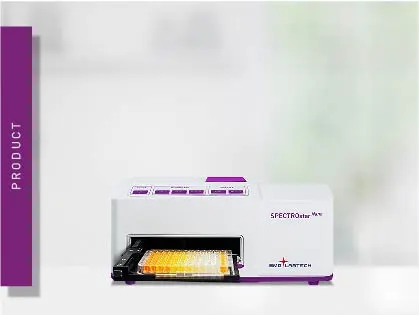
SPECTROstar Nano
Absorbance plate reader with cuvette port
Cancer vaccines are either used to prevent or treat cancer. Preventive vaccination is only partially possible and addresses viruses that are implicated in cancer onset such as human papillomavirus or hepatitis B. Therapeutic cancer vaccines are a type of immunotherapy currently being investigated as a potential new treatment for cancer and will be the focus of this article.
 Dr Andrea Krumm
Dr Andrea Krumm
Researchers are trying to find out whether the principle of vaccines to stimulate the immune system can also be adapted to recognise and destroy cancer cells1. Traditional vaccines keep viral and bacterial infections in check, whereas cancer vaccines should animate the immune system to control cancer cells.
The vaccines are in still in the early stages of development and mainly only available as therapies being tested in trials. Promising results from clinical trials have led to the first cancer vaccine being FDA-approved for advanced prostate cancer, which not only provides a new approach to management of the cancer, but also paves the way for the design and optimization of future vaccines2,3.
The body’s immune response involves two main types of white blood cells: B cells and T cells. B cells produce antibodies that react to toxins, bacteria and some cancer cells and flag them up for attack. However, some substances hide from this process and grow inside body cells.
T cells are able to recognize when a cell has become abnormal and proceed to destroy it. Once abnormal cells have been destroyed, the B cells and T cells become specialized memory cells that can be reactivated if the body ever encounters the abnormal substance or cell again1.
If a cell becomes cancerous, it divides in an uncontrolled manner that sometimes the immune system fails to recognize as abnormal, meaning the cell continues to multiply and grow. The aim of cancer vaccine research is to harness the body’s own immune system such that it recognises cancer cells as abnormal and mounts an attack to destroy them1.
Researchers are currently studying many different vaccine strategies, both clinically and preclinically, but much more work is needed before they fully understand how well the vaccines work and which cancers they may be able to treat2,4.
The most common types of vaccine are antigen vaccines, whole cell vaccines, dendritic cell vaccines, DNA vaccines and anti-idiotype vaccines.
Antigen vaccines are made from the abnormal antigens present on the surface of cancer cells. The antigen stimulates the immune system to attack cancer cells that display that same antigen4.
A whole cell vaccine uses cancer cells (rather than just its antigen) that have been taken from a patient during surgery. The cells are altered to increase the chance of them being attacked by the immune system and are then injected back into the patient. The immune system then attacks these cells or any cells it recognizes as similar5.
Dendritic cell vaccines are composed of the dendritic cells that help the immune system to recognise and attack abnormal cells. They break cancer cells into smaller components (including antigens) that they then display for T cells to recognize. The T cells then attack any cell in the body that displays the same cell surface component5.
DNA vaccines are comprised of DNA sequences from cancer cells that improve the immune system’s ability to respond to and destroy cancer. Anti-idiotype vaccines trigger the immune system to generate antibodies that will bind to and flag up cancer cells for attack4.
Microplate readers play an important role in much of the research that is being carried out to develop or improve cancer immunotherapies. These multimodal, multi-well instruments allow for various absorbance, fluorescence and luminescence measurements to be made simultaneously.
In a 2018 study, Japanese researchers used the PHERAstar® from BMG LABTECH for a time-resolved fluorescence assay that would analyse the effects of interleukin 18 (IL-18) on natural killer (NK) cells derived from patients with lung cancer.
The team were able to show that IL-18 triggered vigorous proliferation of NK cells and conferred them an antigen presenting cell (APC) type phenotype. The APC-like NK cells displayed anti-tumor activity and efficiently killed tumor cells, suggesting that stimulation of NK cells may be a beneficial immunotherapy approach to treating lung cancer6.
In another study published in 2018, researchers used BMG LABTECH’s CLARIOstar to investigate an approach to improving a messenger RNA (mRNA)-based vaccine. These vaccines have been demonstrated as potent activators of the cytotoxic immune system, but their application has been hindered by their vulnerability to nucleases and their difficulty entering APCs.
Using the CLARIOstar, the team were able to show that encapsulation of an mRNA encoding antigen with a certain nanoparticle, effectively stimulated dendritic cell maturation and promoted the activation and proliferation of antigen-specific T cells that had a robust anti-tumor response. In a mouse model, the approach slowed tumor growth in an aggressive form of lymphoma and proved to be a promising method for mRNA vaccine delivery7.
It has been shown, that cancer cells contribute to immunosuppression in the tumor microenvironment by generating the reactive oxidant peroxynitrite Microplate readers can also be used for the detection of tumor-related metabolites as highlighted in the application note ‘Production of peroxynitrite by cancer-associated immune cells can be detected with a fluorescence-based assay’.
These examples demonstrate that BMG LABTECH devices are perfectly suited to study cancer vaccines. Since the deadly blow for tumour cells is often mediated by immune cells, suitable assays measure cell death only in tumour cells, but not in the triggering immune cells. The demanding task is assumed by a time-resolved fluorescence-based method measuring cancer cell death mediated by natural killer cells (presented in application note 1928).
The PHERAstar is the optimal device for high throughput screening in all detection modes and thus allows for screening numerous conditions, concentrations and compounds. The CLARIOstar Plus, on the other hand, is designed for maximum flexibility. It serves cancer vaccine research by quantifying cytokines with simple ELISAs, as well as enabling multiplex kinetic cell assays with atmospheric control unit (ACU).
Its newly developed enhanced dynamic range (EDR) technology in combination with its fast autofocus function further reduces the researcher’s responsibility to decide for the right settings and facilitates assay development9.
With the ongoing efforts being made into improving cancer immunotherapy for safer and more effective targeting of tumors, BMG LABTECH’s microplate devices serve as vital tools in making cancer vaccination a reality.
DELFIA is a trademark of PerkinElmer.
Absorbance plate reader with cuvette port
Powerful and most sensitive HTS plate reader
Most flexible Plate Reader for Assay Development
Upgradeable single and multi-mode microplate reader series
Flexible microplate reader with simplified workflows
Read here, how BMG LABTECH microplate readers can help at advancing cancer immunotherapy research.